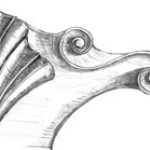We may receive a commission when you use our affiliate links. However, this does not impact our recommendations.

Side Chair, Philadelphia, c.1750
Philadelphia Museum of Art
The axiom “form follows function” guides our designs and our esthetics. I can’t think that there is a woodworker who does not wish his work to be useful. But what is the use? What is the function we seek to answer with our form? For many woodworkers, the function of furniture is comfortable seating or effective storage. Function is smooth sliding drawers. To these woodworkers, 18th century baroque furniture is an anathema. The Shakers felt the moldings and carvings found on 18th c furniture were extraneous, unnecessarily extravagant, and boastful in the eyes of God. But what the Shakers misunderstood is that the moldings and carvings served important esthetic functions: Moldings and carvings unify the designs, inviting the viewer to dwell in their intricacies. But the function of all that effort wasn’t solely an idealistic esthetic pursuit. In the class-conscious 18th century, furniture silently revealed the sophistication of its owner. Fashionable moldings and carvings offered opportunities for upward mobility, and advantageous spouses for one’s children. They were the 18th c version of a college trust fund. Now that’s a functionality I’d like to build into my furniture!
Here are some supplies and tools we find essential in our everyday work around the shop. We may receive a commission from sales referred by our links; however, we have carefully selected these products for their usefulness and quality.








